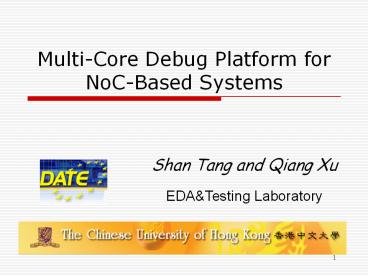Multi-Core Debug Platform for NoC-Based Systems
Title:
Multi-Core Debug Platform for NoC-Based Systems
Description:
1. Multi-Core Debug Platform for NoC-Based Systems. Shan Tang and Qiang Xu. EDA&Testing Laboratory. 2. Background. 1. 3. Silicon Debug for Single Core ... –
Number of Views:62
Avg rating:3.0/5.0
Title: Multi-Core Debug Platform for NoC-Based Systems
1
Multi-Core Debug Platform for NoC-Based Systems
Shan Tang and Qiang Xu EDATesting Laboratory
2
Background
1
3
Silicon Debug for Single Core
- Run Control Interface (e.g., JTAG)
- Widely used in practice
- Not enough for tricky bugs
- Not applicable for certain real-time applications
- Trace Trigger
- Effective in most cases
Challenging yet Well Studied Problem!
4
Multi-Core Debug - Requirements
- Concurrent debug access to interacting cores and
their transactions - System-level triggering and trace
- Debug event synchronization for cores from
multiple clock domains - Limited DfD cost in terms of silicon area,
routing and device pins.
5
Multi-Core Debug Architecture - ARM CoreSight
6
Multi-Core Debug Architecture First Silicon
7
Network-on-Chip
- Most promising communication scheme for future
giga-scale SoCs - NoC generally contains
- Network interface
- Router
- Physical link
- Need debug support as a new design paradigm
8
NoC Monitoring Service
- Ciordas et al. TODAES05, IES06
- Monitoring probe attached at routers
- Effective identifying bit-level errors
- Costly in terms of NoC bandwidth at transaction
level - Monitor instead of Debug
9
Multi-Core Debug Platform for NoC-Based Systems
2
10
Rationale
- How to achieve concurrent debug access?
- Reuse NoC to transfer debug data
- Insert debug probe between core and NI
- How to monitor inter-core transactions in
NoC-based systems - Not shared mechanism cannot simply listen
- How to deal with the latency problem?
- Use QoS guaranteed service for debug connections
- Two-pass debug strategy
11
Proposed Platform
- On-Chip Debug Architecture
- Off-Chip Debug Controller
- Supporting Debug Software
12
On-Chip Debug Architecture
- Core-Level Debug Probe
- Between core and NI
- Monitor transactions
- Control/observe cores debug interface
- System-level Debug Agent
- JTAG ( trace port)
- Controlled by off-chip debug controller
13
Debug Probe Design
14
Trigger Trace Unit Design
15
Debug Agent
- TAP controlled by off-chip debug controller
- Build debug connections between DA and DPs
16
Control On-Chip Debug Registers through DA
17
Supporting Debug Software
- Provide GUI or command line interface
- 3-layer architecture
- Cross debugger
- Core debugger and Transaction debugger
- Multi-core debug driver (PC interfaces)
18
Off-Chip Debug Controller
- Translation layer between debuggers and on-chip
debug architecture - Schedule debug commands/data transfer
- All debug resources in DPs and CUDs are mapped
into addressable registers
19
Debug Access Delay
20
Experimental Results
3
21
A Multi-Core Debug Example
- DP detects a transaction trigger and stop three
interacting cores
22
Simulation Environment
23
Simulation Results Multi-core Concurrent Debug
- Pre-calculated delay can be inserted
- Multiple cores can be concurrently debugged
24
Simulation Results Transaction Trace
- Configurable trigger and trace conditions
- Transactions are recorded when trigger event
happens
25
DfD Area Cost Debug Probe
26
Future Work
- Verify the proposed debug platform in-field
- Introduce DfD units inside NoC to locate the
exact NoC error - NoC without QoS connections for debug?
27
Conclusion
4
28
Q A
Thank you!































